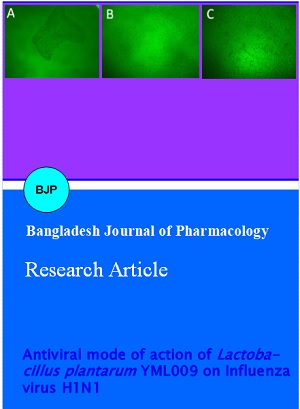Antiviral mode of action of Lactobacillus plantarum YML009 on Influenza virus H1N1
DOI:
https://doi.org/10.3329/bjp.v10i2.23068Keywords:
H1N1, Influenza virus, Lactic acid bacteria, ProbioticAbstract
The development of resistance against antiviral agents has augmented a threat to public health sector. Consequently there is an expanding demand for the development of unconventional antiviral agents that could efficiently replace the existent in-use drugs. The probiotic strains of lactic acid bacteria (LAB) have earned the status of being efficient, economical and safe 'nutraceutical' in health care armamentarium. A total of 2272 LAB strains were screened against H1N1 virus. The isolate YML009 displayed a pronounced antiviral activity. Sequencing and biochemical assays identified the isolate as Lactoballius plantarum which, exhibited resistance to the damage caused by the acidic conditions such as gastric juice and 5% bile salt. The anti-H1N1 activity of the strain was confirmed by hemagglutination assay and was found to display enhanced efficacy in comparison to the commercially available antiviral drug. This is a primary report on anti-influenza activity of a bacterium L. plantarum YML009.
Downloads
722
489 Read
376

Additional Files
Published
How to Cite
Issue
Section
License
Authors who publish with this journal agree to the following terms:
- Authors retain copyright and grant the journal right of first publication with the work simultaneously licensed under a Creative Commons Attribution License that allows others to share the work with an acknowledgement of the work's authorship and initial publication in this journal.
- Authors are able to enter into separate, additional contractual arrangements for the non-exclusive distribution of the journal's published version of the work (e.g., post it to an institutional repository or publish it in a book), with an acknowledgement of its initial publication in this journal.
- Authors are permitted and encouraged to post their work online (e.g., in institutional repositories or on their website) prior to and during the submission process, as it can lead to productive exchanges, as well as earlier and greater citation of published work (See The Effect of Open Access).
